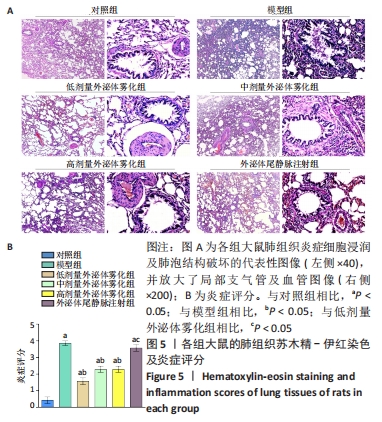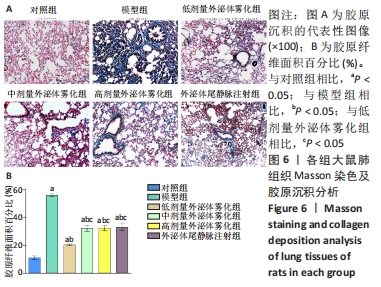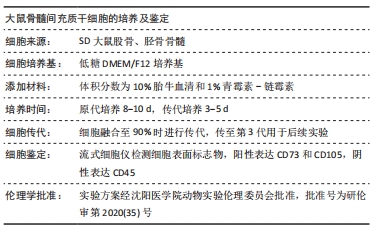[1] NGUYEN JMK, ROBINSON DN, SIDHAYE VK. Why new biology must be uncovered to advance therapeutic strategies for chronic obstructive pulmonary disease. Am J Physiol Lung Cell Mol Physiol. 2021;320(1):L1-L11.
[2] SUNDAR IK, RASHID K, SELLIX MT, et al. The nuclear receptor and clock gene REV-ERBα regulates cigarette smoke-induced lung inflammation. Biochem Biophys Res Commun. 2017;493(4):1390-1395.
[3] SRIVASTAVA K, THAKUR D, SHARMA S, et al. Systematic review of humanistic and economic burden of symptomatic chronic obstructive pulmonary disease. Pharmacoeconomics. 2015;33(5):467-488.
[4] PALLI SR, ZHOU S, SHAIKH A, et al. Effect of compliance with GOLD treatment recommendations on COPD health care resource utilization, cost, and exacerbations among patients with COPD on maintenance therapy. J Manag Care Spec Pharm. 2021;27(5):625-637.
[5] OLSCHEWSKI H, BUHL R, FUNK GC, et al. Chronisch-obstruktive Lungenerkrankung 2021 – die richtige Therapie für den richtigen Patienten [Chronic obstructive pulmonary disease: the right treatment for the right patient]. Internist (Berl). 2021;62(6):679-685.
[6] MAKE B, DUTRO MP, PAULOSE-RAM R, et al. Undertreatment of COPD: a retrospective analysis of US managed care and medicare patients. Int J Chron Obstruct Pulmon Dis. 2012;7:1-9.
[7] CECCARIGLIA S, CARGNONI A, SILINI AR, et al. Autophagy: a potential key contributor to the therapeutic action of mesenchymal stem cells. Autophagy. 2020;16(1):28-37.
[8] KIM HO, CHOI SM, KIM HS. Mesenchymal stem cell-derived secretome and microvesicles as a cell-free therapeutics for neurodegenerative disorders. Tissue Eng Regen Med. 2013;10(3):93-101.
[9] MOHAMMADIPOOR A, ANTEBI B, BATCHINSKY AI, et al. Therapeutic potential of products derived from mesenchymal stem/stromal cells in pulmonary disease. Respir Res. 2018;19(1):218.
[10] HARRELL CR, MILORADOVIC D, SADIKOT R, et al. Molecular and cellular mechanisms responsible for beneficial effects of mesenchymal stem cell-derived product “Exo-d-MAPPS” in attenuation of chronic airway inflammation. Anal Cell Pathol (Amst). 2020;2020:3153891.
[11] WILLIS GR, FERNANDEZ-GONZALEZ A, ANASTAS J, et al. Mesenchymal stromal cell exosomes ameliorate experimental bronchopulmonary dysplasia and restore lung function through macrophage immunomodulation. Am J Respir Crit Care Med. 2018;197(1):104-116.
[12] MONSEL A, ZHU YG, GENNAI S, et al. Therapeutic effects of human mesenchymal stem cell-derived microvesicles in severe pneumonia in mice. Am J Respir Crit Care Med. 2015;192(3):324-336.
[13] DU YM, ZHUANSUN YX, CHEN R, et al. Mesenchymal stem cell exosomes promote immunosuppression of regulatory T cells in asthma. Exp Cell Res. 2018;363(1): 114-120.
[14] WAN X, CHEN S, FANG Y, et al. Mesenchymal stem cell-derived extracellular vesicles suppress the fibroblast proliferation by downregulating FZD6 expression in fibroblasts via micrRNA-29b-3p in idiopathic pulmonary fibrosis. J Cell Physiol. 2020;235(11):8613-8625.
[15] LEE C, MITSIALIS SA, ASLAM M, et al. Exosomes mediate the cytoprotective action of mesenchymal stromal cells on hypoxia-induced pulmonary hypertension. Circulation. 2012;126(22):2601-2011.
[16] O’FARRELL HE, YANG IA. Extracellular vesicles in chronic obstructive pulmonary disease (COPD). J Thorac Dis. 2019;11(Suppl 17):S2141-S2154.
[17] BORGHARDT JM, KLOFT C, SHARMA A. Inhaled therapy in respiratory disease: the complex interplay of pulmonary kinetic processes. Can Respir J. 2018;2018: 2732017.
[18] GRÄSSEL S, STÖCKL S, JENEI-LANZL Z. Isolation, culture, and osteogenic/chondrogenic differentiation of bone marrow-derived mesenchymal stem cells. Methods Mol Biol. 2012;879:203-267.
[19] SUN D, OUYANG Y, GU Y, et al. Cigarette smoke-induced chronic obstructive pulmonary disease is attenuated by CCL20-blocker: a rat model. Croat Med J. 2016;57(4):363-370.
[20] HERR C, HAN G, LI D, et al. Combined exposure to bacteria and cigarette smoke rebles characteristic phenotypes of human COPD in a murine disease model. Exp Toxicol Pathol. 2015;67(3):261-269.
[21] GUAN XJ, SONG L, HAN FF, et al. Mesenchymal stem cells protect cigarette smoke-damaged lung and pulmonary function partly via VEGF-VEGF receptors. J Cell Biochem. 2013;114(2):323-335.
[22] GU W, SONG L, LI XM, et al. Mesenchymal stem cells alleviate airway inflammation and emphya in COPD through down-regulation of cyclooxygenase-2 via p38 and ERK MAPK pathways. Sci Rep. 2015;5:8733.
[23] CHURG A, WANG RD, TAI H, et al. Macrophage metalloelastase mediates acute cigarette smoke-induced inflammation via tumor necrosis factor-alpha release. Am J Respir Crit Care Med. 2003;167(8):1083-1089.
[24] KIM YS, KIM JY, HUH JW, et al. The therapeutic effects of optimal dose of mesenchymal stem cells in a murine model of an elastase induced-emphya. Tuberc Respir Dis (Seoul). 2015;78(3):239-245.
[25] ZHEN G, LIU H, GU N, et al. Mesenchymal stem cells transplantation protects against rat pulmonary emphya. Front Biosci. 2008;13:3415-3422.
[26] KIM SY, LEE JH, KIM HJ, et al. Mesenchymal stem cell-conditioned media recovers lung fibroblasts from cigarette smoke-induced damage. Am J Physiol Lung Cell Mol Physiol. 2012;302(9):L891-908.
[27] LI J, LI D, LIU X, et al. Human umbilical cord mesenchymal stem cells reduce systemic inflammation and attenuate LPS-induced acute lung injury in rats. J Inflamm (Lond). 2012;9(1):33.
[28] FREDENBURGH LE, PERRELLA MA, MITSIALIS SA. The role of heme oxygenase-1 in pulmonary disease. Am J Respir Cell Mol Biol. 2007;36(2):158-165.
[29] WEISS DJ, CASABURI R, FLANNERY R, et al. A placebo-controlled, randomized trial of mesenchymal stem cells in COPD. Chest. 2013;143(6):1590-1598.
[30] STOLK J, BROEKMAN W, MAUAD T, et al. A phase I study for intravenous autologous mesenchymal stromal cell administration to patients with severe emphya. QJM. 2016;109(5):331-336.
[31] LE THI BICH P, NGUYEN THI H, DANG NGO CHAU H, et al. Allogeneic umbilical cord-derived mesenchymal stem cell transplantation for treating chronic obstructive pulmonary disease: a pilot clinical study. Stem Cell Res Ther. 2020;11(1):60.
[32] AVERYANOV A, KOROLEVA I, KONOPLYANNIKOV M, et al. First-in-human high-cumulative-dose stem cell therapy in idiopathic pulmonary fibrosis with rapid lung function decline. Stem Cells Transl Med. 2020;9(1):6-16.
[33] VOLAREVIC V, MARKOVIC BS, GAZDIC M, et al. Ethical and safety issues of stem cell-based therapy. Int J Med Sci. 2018;15(1):36-45.
[34] GLASSBERG MK, MINKIEWICZ J, TOONKEL RL, et al. Allogeneic Human Mesenchymal Stem Cells in Patients With Idiopathic Pulmonary Fibrosis via Intravenous Delivery (AETHER): A Phase I Safety Clinical Trial. Chest. 2017;151(5): 971-981.
[35] DUIJVESTEIN M, VOS AC, ROELOFS H, et al. Autologous bone marrow-derived mesenchymal stromal cell treatment for refractory luminal Crohn’s disease: results of a phase I study. Gut. 2010;59(12):1662-1669.
[36] DHERE T, COPLAND I, GARCIA M, et al. The safety of autologous and metabolically fit bone marrow mesenchymal stromal cells in medically refractory Crohn’s disease - a phase 1 trial with three doses. Aliment Pharmacol Ther. 2016;44(5):471-481.
[37] GAZDIC M, VOLAREVIC V, ARSENIJEVIC N, et al. Mesenchymal stem cells: a friend or foe in immune-mediated diseases. Stem Cell Rev Rep. 2015;11(2):280-287.
[38] HARRELL CR, FELLABAUM C, JOVICIC N, et al. Molecular mechanisms responsible for therapeutic potential of mesenchymal stem cell-derived secretome. Cells. 2019;8(5):467.
[39] KARDIA E, HALIM NSSA, YAHAYA BH. Aerosol-based cell therapy for treatment of lung diseases. Methods Mol Biol. 2016;1516:243-255.
[40] KIM WY, HONG SB. Sepsis and Acute Respiratory Distress Syndrome: Recent Update. Tuberc Respir Dis (Seoul). 2016;79(2):53-57.
[41] ZHANG E, GENG X, SHAN S, et al. Exosomes derived from bone marrow mesenchymal stem cells reverse epithelial-mesenchymal transition potentially via attenuating Wnt/β-catenin signaling to alleviate silica-induced pulmonary fibrosis. Toxicol Mech Methods. 2021;31(9):655-666.
[42] RIDZUAN N, ZAKARIA N, WIDERA D, et al. Human umbilical cord mesenchymal stem cell-derived extracellular vesicles ameliorate airway inflammation in a rat model of chronic obstructive pulmonary disease (COPD). Stem Cell Res Ther. 2021;12(1):54.
[43] KIM SY, BURGESS JK, WANG Y, et al. Atomized Human Amniotic Mesenchymal Stromal Cells for Direct Delivery to the Airway for Treatment of Lung Injury. J Aerosol Med Pulm Drug Deliv. 2016;29(6):514-524.
[44] HALIM NSS, CH’NG ES, KARDIA E, et al. Aerosolised Mesenchymal Stem Cells Expressing Angiopoietin-1 Enhances Airway Repair. Stem Cell Rev Rep. 2019; 15(1):112-125.
[45] DINH PC, PAUDEL D, BROCHU H, et al. Inhalation of lung spheroid cell secretome and exosomes promotes lung repair in pulmonary fibrosis. Nat Commun. 2020; 11(1):1064.
[46] BARI E, FERRAROTTI I, TORRE ML, et al. Mesenchymal stem/stromal cell secretome for lung regeneration: The long way through “pharmaceuticalization” for the best formulation. J Control Release. 2019;309:11-24.
[47] A Pilot Clinical Study on Inhalation of Mesenchymal Stem Cells Exosomes Treating Severe Novel Coronavirus Pneumonia. https://clinicaltrials.gov/ct2/show/NCT04276987[2022-03-04]
[48] DOLOVICH MB, AHRENS RC, HESS DR, et al. Device selection and outcomes of aerosol therapy: Evidence-based guidelines: American College of Chest Physicians/American College of Asthma, Allergy, and Immunology. Chest. 2005;127(1):335-371.
[49] OTERO-ORTEGA L, GÓMEZ DE FRUTOS MC, LASO-GARCÍA F, et al. Exosomes promote restoration after an experimental animal model of intracerebral hemorrhage. J Cereb Blood Flow Metab. 2018;38(5):767-779.
[50] CHANDEL A, GOYAL AK, GHOSH G, et al. Recent advances in aerosolised drug delivery. Biomed Pharmacother. 2019;112:108601.
[51] MCCARTHY SD, HORGAN E, ALI A, et al. Nebulized mesenchymal stem cell derived conditioned medium retains antibacterial properties against clinical pathogen isolates. J Aerosol Med Pulm Drug Deliv. 2020;33(3):140-152.
[52] SHI MM, YANG QY, MONSEL A, et al. Preclinical efficacy and clinical safety of clinical-grade nebulized allogenic adipose mesenchymal stromal cells-derived extracellular vesicles. J Extracell Vesicles. 2021;10(10):e12134.
|









